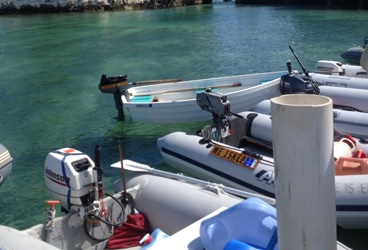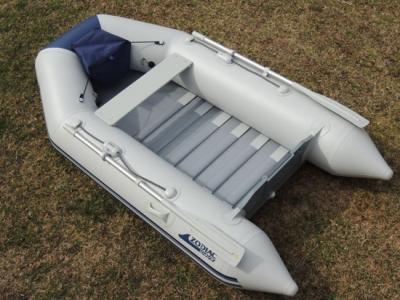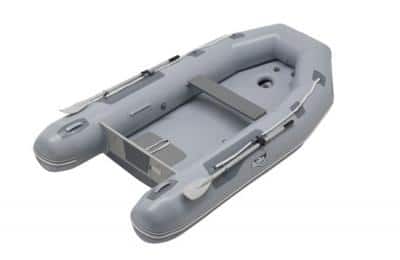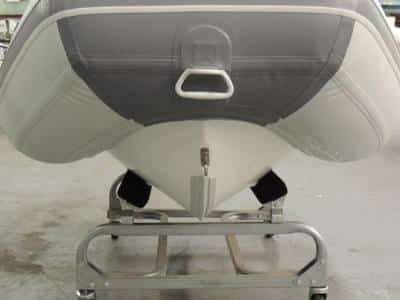
One of the more important choices you’ll make while outfitting to go cruising is what kind of dinghy boat you want. And there are plenty of options: hard vs. inflatable? If you choose an inflatable, should you go with a roll-up floor? An inflatable floor? A RIB? Do you need Hypalon?
Your dinghy boat is basically your car when you’re cruising, so you’ll want to choose wisely. Here I will go through some of the pros and cons of each type of dink so you’ll know what to look for when it’s time for a new tender.
Before you start looking at boats, consider what your needs are, your budget, where you plan to store the boat, if you plan to tow the boat, and how you’ll power it.
Inflatable-Boat Options
Roll-up Floor: If space is at a premium, an inflatable with a roll-up floor may be right for you. Roll-ups are lightweight, and the floor slats are enclosed in the fabric, so you don’t need to remove them to fold up the dinghy for storage. The bottom is flat, so the boat won’t plane off, and you’ll only need a small outboard, probably around 4 horsepower, to power it. Roll-ups don’t typically tow very well, but since they stow so easily, this may not matter.
Pros: lightweight; stows easily; low cost
Cons: Could damage the bottom if you pull it onto a rocky beach; limited range (if speed is an issue); does not track as well as a more v-shaped hull; limited floor support

Zodiac Wave
High-pressure Inflatable Floor: Like the roll-up floor, the high-pressure inflatable floor can stow easily, and setup time is super quick. The bottom of the boat has a V-shape due to an inflatable keel tube, so this style of inflatable tracks better than a flat-bottom dinghy. Due to its light weight and the hull shape, an inflatable hull dinghy can also hop on a plane with as little as a 5-horse outboard for a single rider.
Pros: lightweight, stows easily, tracks well, can plane
Cons: Not as resilient to a puncture from a sharp object, or from a rocky beach; if you cruise in an area where the water is cold, or with big temperature differences through the day/night, the floor may feel “squishy” at times due to the air condensing.

Achilles
Solid-Panel Floor: Inflatables with a solid-panel floor are heavier than those with a roll-up or inflatable floor. As such, they can typically handle a larger outboard engine, and depending on the shape of the bottom, can plane. The solid panels can be made out of wood, aluminum, or a composite plastic, and aluminum stringers increase the rigidity. Since the panels can be time consuming to both setup and remove, a solid-panel floor inflatable might be best for someone who only needs to set the dinghy up at the beginning of the season and put it away at the end.
Pros: typically better performance than a roll-up dinghy; low cost; solid underfoot
Cons: setup time; floorboards can be difficult to stow

Zodiac Cadet
Rigid Inflatable Boat: RIBs have a solid, V-shaped bottom. This type of inflatable has increased in popularity with cruisers in recent years, and for good reason—they offer excellent performance and stability and can take being pulled ashore. On the flip side, RIBs can be pricey, heavy, and difficult to stow. They work well on davits, however, and many cruisers end up stowing RIBs flipped over on the foredeck. If weight is an issue, RIBs with aluminum floors are available and are much lighter than fiberglass (but cost more).
Pros: fast; with a large outboard, one can easily explore large areas; high carrying capacity; can handle rocky beaches
Cons: more expensive; boats with the fiberglass bottoms are heavy; can be difficult to stow on smaller boats

Defender RIB
Fabric Choices
Inflatable boats are available in either PVC or Hypalon, which is a neoprene-coated nylon. The construction methods between the boats are different as well—PVC boats are typically heat welded at the seams, and Hypalon boats are hand glued. Both materials are rugged and durable; however, Hypalon is more UV resistant, so if you plan to use the boat in the tropics, this material will be your best bet. PVC boats are typically less expensive. Whichever you choose, you will get more life out of the boat if you wash the salt off and wipe the fabric down with 303 Aerospace Protectant every few weeks. Some cruisers in the southern latitudes like to keep their inflatables covered with canvas dinghy “chaps” as well.
A Hard Choice
Although inflatables seem to be the overwhelming choice for a tender, they aren’t the only option. Hard dinghies from Trinka, Fatty Knees, Dyer, Bauer, and Walker Bay all have loyal followings in the cruising community. These boats can all row well, are sturdy, don’t deflate (obviously), and most come with a sailing rig as well. I’ve cruised throughout the Bahamas with an 8-foot Trinka as our dinghy and found it to be easy to row and tracked well when being towed behind the boat. (For more on why a solid dinghy might be right for you, check out “Inflatable? That’s Debatable,” a point-of-view piece by Connie McBride.)
Can’t decide? Another option is this cool hybrid design from Walker Bay called a “rigid inflatable dinghy” that combines the best features of hard and inflatable boats, or even a hard dinghy—the Porta-Bote—that can fold to only four inches flat.
### Inflatable Boat Resources:
AB
Achilles
Apex
Caribe
Defender
Mercury
Walker Bay
West Marine
Zodiac








